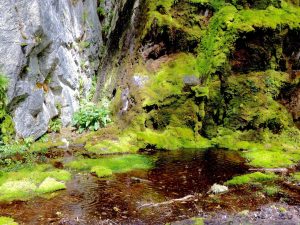By Professor Robert Fleming
Only a few island groups on our planet have remained mostly free of human impact and with good fortune, a portion of the Tierra del Fuego Archipelago, below the Beagle Channel, is one of these. Here lies the small (244km2/94mi2) Cape Horn National Park, which encompasses both shallow marine habitats along with the island groups of Wollaston and Hermite. Cape Horn Island itself is a miniscule part of the reserve.
Some of the islands below the Beagle Channel are treeless andexhibit tundra formations as well as alpine habitats, these often intermixed with freshwater ecosystems such as peat bogs that are repleat with species of Sphagnummosses. Indeed, the whole region is a bryophyte hotspot, especially well known for its great diversity of cold-adapted liverworts and mosses.

Shaded areas on islands west of the Darwin range are conducive to fern and moss growth.
In addition, other islands in the region are partly covered with a mixture of southern evergreen forests or subpolar deciduous forests. A main component of the former is the southern beech Nothfagus betuloides, and the white-flowered Drimys winteri (in the Winteraceae family). While the deciduous forests are mostly composed of the southern beeches, Nothofagus pumilioand N. antarctica.
